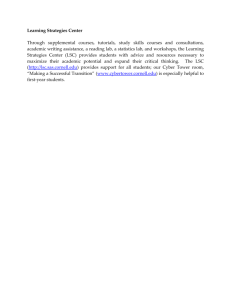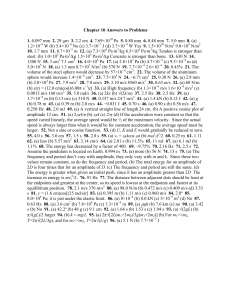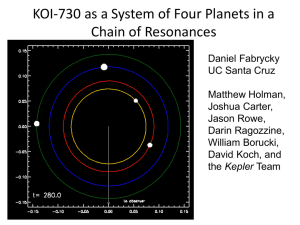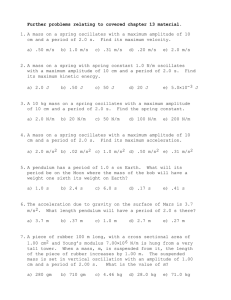LASER INTERFEROMETER GRAVITATION WAVE OBSERVATORY -LIGO- CALIFORNIA INSTITUTE OF TECHNOLOGY
advertisement
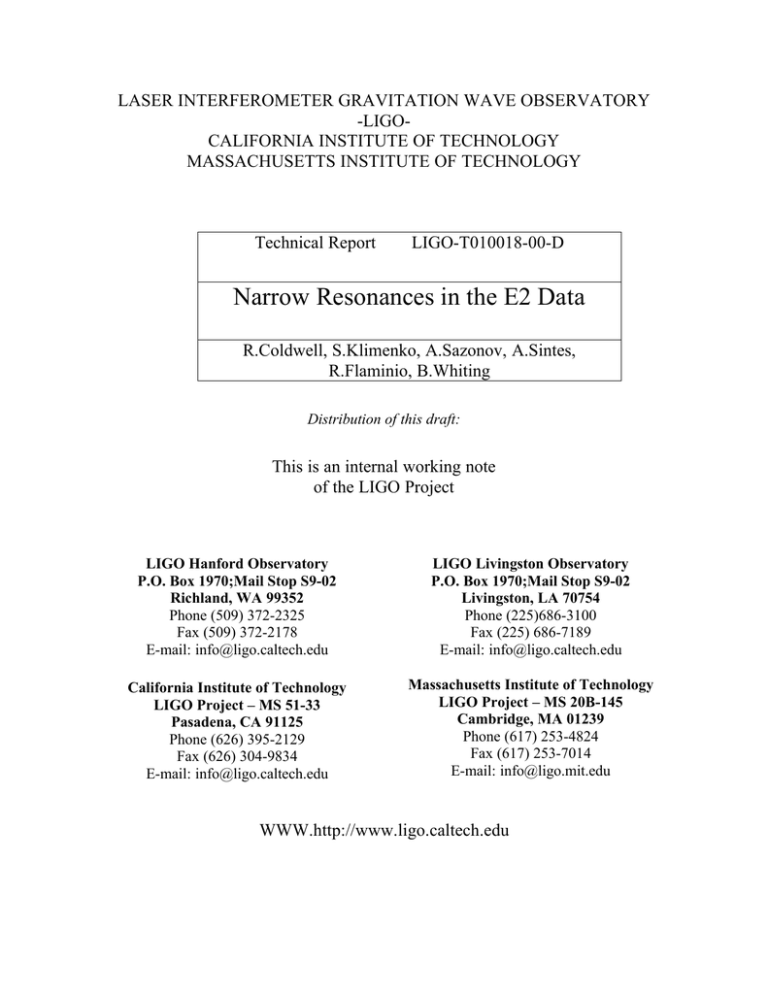
LASER INTERFEROMETER GRAVITATION WAVE OBSERVATORY -LIGOCALIFORNIA INSTITUTE OF TECHNOLOGY MASSACHUSETTS INSTITUTE OF TECHNOLOGY Technical Report LIGO-T010018-00-D Narrow Resonances in the E2 Data R.Coldwell, S.Klimenko, A.Sazonov, A.Sintes, R.Flaminio, B.Whiting Distribution of this draft: This is an internal working note of the LIGO Project LIGO Hanford Observatory P.O. Box 1970;Mail Stop S9-02 Richland, WA 99352 Phone (509) 372-2325 Fax (509) 372-2178 E-mail: info@ligo.caltech.edu LIGO Livingston Observatory P.O. Box 1970;Mail Stop S9-02 Livingston, LA 70754 Phone (225)686-3100 Fax (225) 686-7189 E-mail: info@ligo.caltech.edu California Institute of Technology LIGO Project – MS 51-33 Pasadena, CA 91125 Phone (626) 395-2129 Fax (626) 304-9834 E-mail: info@ligo.caltech.edu Massachusetts Institute of Technology LIGO Project – MS 20B-145 Cambridge, MA 01239 Phone (617) 253-4824 Fax (617) 253-7014 E-mail: info@ligo.mit.edu WWW.http://www.ligo.caltech.edu 1 Introduction Narrow resonances in the LIGO detector are one of the noise sources that may affect the detection of gravitation waves. Thus, a detailed study of this noise (or line noise) is important for understanding of the LIGO data. It’s also essential for the commissioning and operation of the LIGO detectors. The narrow resonances can be roughly divided into two groups: the mechanical resonances (MR) and the environmental resonances (ER). The mechanical resonances are intrinsic for the LIGO interferometers and associated with the internal resonances of the optics, the optics suspension (pendulum and violin modes) and the mount and support structure of the optics. A list of expected mechanical resonances in the LIGO interferometers can be found elsewhere [1]. The environmental resonances are not intrinsic for the LIGO interferometers, but enter through electrical equipment connected to the instrument or through the optics suspension system. They could be resonances generated by pumps, motors or air handling equipment. A particular example of the ER is the AC power interference (60Hz and its harmonics). 2 E2 Run Data To study narrow resonances a contiguous block of data approximately 80 hours long was used. It starts on November 9 at 9:17:47 am, the UTC start time is 657796678. This data corresponds to the configuration with two arms in lock. Mainly the resonances in the dark port LSC-AS_Q channel were studied. Figure 1 shows typical power spectra for this channel. The interferometer noise in this channel was 4-5 orders of magnitude higher then nominal, which sometimes made it hard to detect resonances and do their detailed study (like phase analysis). Many expected mechanical resonances can’t be even seen in the data. Figure 1. The example of power spectra for the LSC-AS_Q channel. Figure 2. The example of power spectra for the LSC-AS_Q channel: 0-100Hz. 3 Monitoring of Narrow Resonances The narrow resonances are seen as lines in the data power spectra. The goal of the line noise characterization is to identify and characterize those lines. For this purpose we used a line monitor (LM) developed at UF using the Quasi-Monochromatic Line Removal (QMLR) method [2]. In some cases there could be several resonances with very close frequencies that can’t be resolved by the monitor due to noise in the data. These resonances are then characterized as a single line. The line interference can be described as a sum of a quasi-monochromatic signal m(t) and a stochastic noise n(t) associated with the line. The signal m(t) can be regarded as a random process, produced by random modulation of a harmonic oscillation of frequency ω : m(t)=a(t)cos( ω t+p(t)), where the amplitude a(t) and phase p(t) vary in time, in accordance with some statistical law. To qualify this process as a quasi-monochromatic signal the bandwidth of the modulation (or line width) should be very small compare to the carrier frequency ω . Typically the line width (W) is a fraction of a Hertz. Given a stretch of data of duration T the QMLR methods estimates a, ω and p, assuming that W<1/T. Usually m(t) is not a stationary process. The line’s amplitude and frequency estimated for a set of consecutive data stretches may slowly vary with time (see Figure 4b). Although the time T was different for different lines (typically 10sec), we have averaged the a and ω to get 1min (to be precise 64 sec) trend data. If a line consists of a several resonances, often the monitor will switch between them, picking up a resonance with higher intensity. In this case a histogram of the line frequency ω shows several peaks corresponding to the different resonances (see Figure 3(a)). 4 Lines observed in the interferometer channels. A summary of lines observed in the E2 date for the dark port channel (H2:LSC_AS_Q) is given in Table.1. It has five columns that give the frequency (F), approximate width (W), average amplitude (A), average Signal to Nose Ratio (SNR) and possible source of a line. The SNR is calculated as a ratio of the estimated line intensity to the noise intensity on the output of the QMLR filter. For many lines the frequency varies with time, that is marked with a letter “V” in the frequency field. In some cases the source of resonance is unknown or we are not sure about it. The case is then marked with a question mark (?). The last column indicates a system where the lines are observed. For example the LSC means that a line is likely to be present also in the other LSC channels: LSC-AS_I, LSCREFL_I, LSC-REFL_Q, etc. There were calibration resonances with well known frequencies injected into the system. Their frequencies are marked as “xx1.25”, “xx2.75”, etc, where “xx” stands for “3,7,27,90”. Table 1. List of resonances observed in the H2:LSC-AS_Q & H2:LSC-AS_I channels. F, W, Hz A, SNR Source System HZ Rms a.e. 0.729 0.014 1.42 1.8 BS,RM,ITM,ETM pendulum 0.793 0.007 4.67 12.6 SO(2K) pendulum Guess 5.785 0.031 5.87 1.6 ? LSC, IOO 6.086 0.057 8.54 1.3 ? 12.050 0.026 12.19 4.1 HAM stack LSC, IOO 17.286 0.027 3.42 1.7 ? LSC, IOO(?) 17.625 0.015 7.16 7.0 ? 34.943 0.035 2.02 1.3 Office area air handler LSC, IOO 53.274 0.086 0.86 0.6 HVAC system (?) LSC, IOO 53.580 .0.031 23.4 9.9 60.000 (V) <0.01 3.75 5.4 Power lines LSC,IOO,… 98.578 0.020 1.24 2.0 ? LSC, IOO 98.734 0.010 6.10 20.4 ? 206.6 (V) ~0.05 1.52 10.9 ? LSC 207.2 (V) <0.05 0.16 0.7 ? 237.0 (V) <0.05 0.84 5.7 ? LSC xx1.25 ITMX calibration lines LSC xx1.75 ITMY calibration lines LSC xx2.25 ETMX calibration lines LSC xx2.75 ETMY calibration lines LSC 1258.6 (V) <0.1 0.07 4.9 ? LSC 3018, 3027 ? LSC 3034, 3040 frequency drift ~0.5Hz/day 3094, 3054 0.2-0.5 3094, 3114 3192 (V) 3783 <0.05 0.2 14.0 4 resonances LSC 5142, 6751.5, LSC 6751.9, 7130, 7134, 0.2-0.5 6929 (V) 4 resonances 2048, 4096 Sampling artifacts (1,2,3 LSC 6144 harmonics) 4.1 0.7-0.8Hz lines There is a group of resonances due to the pendulum motion of mirrors (BS, RM, ITM, ETM) with approximately the same frequency of 0.74-0.75Hz. The Line Monitor can’t resolve this resonances and they are seen as a single line (Fig.3a) with mean of 0.729Hz and width of 0.033Hz (fwhm). Another narrow line at 0.793Hz is probably due to the small optics (2K) pendulum pitch mode that has a frequency of 0.79Hz (as measured at LHL). The amplitude distribution for both lines is shown in Figure 3(b). a b 0.729Hz 0.793Hz Figure 3. a-frequency histogram, b-amplitude distribution for 0.729Hz (black) and 0.793Hz (blue) lines. Figure 4 shows the amplitude trend data (1min trend). The amplitude of the 0.729Hz line (Fig.4(a)) is affected by noise (SNR=1.7) and varies randomly with time. The 0.793Hz line (Fig.4(b)) has larger amplitude (SNR=15) and systematically increase in the end of the lock section. a b Figure 4. Amplitude trend data for 0.728Hz (a) and 0.793Hz (b) lines. 4.2 6.00Hz lines Two lines are present in the LSC-AS_Q channel at this frequency (Fig.5(a)): 5.785Hz (first line) and 6.087Hz (second line). Since lines with very close frequencies are present in the IOO-MC_F channel (5.814Hz and 6.089Hz respectively), it could be the BSC stack modes: horizontal-horizontal, horizontal-pitch, vertical-vertical. Some disagreement in frequency for the first line could be due to the presence of several resonances in the line. The frequency and amplitude trend data (1min trend) is shown in Figures 6 and 7 a b Figure 5. Lines observed in the LSC-AS_Q (a) and the IOO-MC_F (b) channels. Figure 6. Amplitude and frequency trend data for the first line, both for the LSC-AS_Q and IOO-MC_F channels. Figure 7.1. LSC-AS_Q channel: amplitude and frequency trend data for the second line. Figure 7.2. IOO-MC_F channel: amplitude and frequency trend data for the second line. 4.3 12.05Hz line This narrow line is observed both in the LSC-AS_Q and IOO-MC_F channels. Although the measured frequency is slightly different (12.05 Hz and 12.07 Hz respectively), we consider it to be the same line that corresponds to the HAM stack resonance (12.1 Hz). Figure 8 shows frequency and amplitude trend data (1min trend) for both channels. a b c d Figure 8. 12.05 Hz line data for the LSC-AS_Q (black) and IOO-MC_F (red) channels. (a) – frequency histogram, (b) – frequency trend data, (c,d) – amplitude trend data. 4.4 17.5Hz lines Two narrow lines at 17.283 Hz and 17.625 Hz are present in the LSC-AS_Q and LSC-LS channels. Figure 9 shows the amplitude and frequency trend data for these lines. Although the measured frequencies don’t match any expected mechanical resonance, we suspect these lines could be one of the mechanical origin, because the line frequencies are very stable with time. Figure 9. LSC-AS_Q channel: amplitude and frequency data for two lines around 17.5 Hz. (a) – frequency histogram, (b) – amplitude as a function of time (red – 17.283 Hz, black – 17.625 Hz), (c,d) – frequency as a function of time. Similar lines were observed in the IOO-MC-F channel (Fig.10). The mean of right (left) histogram is 17.63 Hz (17.29 Hz) respectively. The lines are very weak compared to the noise (SNR < 0.1), so the frequency is measured with bigger error then for the LSCAS_Q channel (SNR~10). Figure 10. IOO-MC_F channel: (a) – frequency histogram, (b) – frequency evolution with time. 4.5 34.95Hz line No mechanical resonances are expected at this frequency. We assume that this is an environmental line possibly coming from a fan in the office area air handler (expected frequency ~35Hz). This line is clearly seen in the LSC-AS_Q and IOO-MC_F channels. Figures 11.1, 11.2 show the measured frequency and amplitude. Figure 11.1. Frequency histogram and trend data: black - LSC-AS_Q channel, red – IOOMC_F channel. Figure 11.2.Amplitude trend data: black - LSC-AS_Q channel, red – IOO-MC_F channel. 4.6 53.58Hz line Actually there are two lines in the frequency band between 53-54 Hz (Fig.12(a)), but one of them is very weak and hard to measure. The lines are present both in the LSCAS_Q (53.274 Hz, 53.580Hz) and IOO-MC_F (53.350 Hz, 53.581Hz) channels. Figures 12(d,f) shows strong correlation between these two channels for the stronger line (53.580 Hz). This line was not present at the beginning of the run (Fig.12(c)) and appeared in the data at the UTC time around 65793767 (~40 hours from the beginning of the run). a b c e d f Figure 12. Lines around 53.5 Hz for LSC-AS_Q (a) and IOO-MC_F (b) channels. (c,d,e,f) – frequency and amplitude trend data: black – LSC-AS_Q, red – IOO-MC_F. Since these lines occur at the low end of the acoustic frequency range, correlation with sound sources within the building was investigated. Although 25 microphone channels are listed in Daniel Sigg’s 1999 list [3], only 15 were apparently hooked up (four were dead: PEM-BSC10_MIC, PEM-BSC9_MIC, PEM-BT4_MIC, and PEM-BT5_MIC), and none showed any correlation whatsoever with the 53-4 Hz noise being investigated. After discussion with Stan Whitcomb, it was suggested that this noise was due to components of the HVAC system located across the road from the building, and communicated to the interferometer through the ground, not through an air path. Subsequent examination of accelerometer signals, particularly from the PSL table, supported this [4]. Evidence of this noise source was also found in the H2:IOO-MC_F frequency control signal which inputs to the PSL table. While these narrow line signals are currently outside the sensitive band-pass of the LIGO instruments, they could become a concern if further non-linear effects mixed them up to higher frequencies. 4.7 60Hz line and its harmonics Power is one of the environmental line noise sources. Power is delivered as a sinusoidal signal with amplitude of about 170 V and frequency of 60 Hz. It manifests itself in the interferometer data channels as a series of lines that are harmonics of 60Hz power line. By comparison with the 40 m data from Caltech, mains line harmonics are a much weaker feature in the E2 data. For the purposes of this study both the online MultiVolt power grid monitor [5] and the QMLR line monitor were operational. Multivolt is set up to display the current one-minute summary of harmonics present in 11 separate monitors of the power line voltages at Hanford (the active summary can be found at http://blue.ligo-wa.caltech.edu/gds/monitor_reports/MultiVolt/summary.html ). The MultiVolt monitor summaries are available as trend data. In surveying the MultiVolt output during the E2 run, it was found that one channel (H0:PEM-EX_V1) contained only digitized noise (and still does today – 1/25/01). In all ten working channels, the 5th harmonic was consistently the strongest of all those recorded (up to 17th), at a little over 2% of the fundamental, with the 7th being next at generally around 1%. The RMS amplitude varied by nearly 5% between the various monitoring sites, and mostly, the phase angles (with respect to the fundamental) of the strongest two higher harmonics fell within a ±10-15º interval for all of the ten working channels. Figure 13.1 shows the example of power spectra for one of the power voltage channels and the values of phase at vertex and middle stations. a b Figure 13.1. Power monitoring channel: (a) – power spectra, (b) – phase in the vertex and middle stations. For the 16 kHz data channels there should be around 136 power lines. In the E2 run, actually only first 7 harmonics can be seen in the dark port channel. Table 2 shows their relative intensity. harmonic 1 2 3 4 5 intensity, % 33.6 37.8 16.8 8.6 1.3 Table 2. Relative intensity of the first 7 power lines 6 0.4 7 1.3 The QMLR line monitor estimates the line fundamental frequency f0 assuming that harmonics have frequency nf0, where n is a harmonic number. Figure 13.2 shows variation of the line fundamental frequency and total amplitude as a function of time. Figure 13.2. The frequency and amplitude (first 7 harmonics) trend data for the power lines in the LSC-AS_Q channel. At any instant (e.g. in 1 min trend) the fundamental frequency seems to have been substantially consistent across all power monitoring channels (a few parts in 105). 4.8 98.6Hz line Running the line monitor, we expected to measure a single resonance. However the monitor data shows at least 2 resonances present at this frequency (Fig.14.1), which are also quite non-stationary. The 98.6 line is present both in the LSC-AS_Q (black) and IOO-MC_F(red) channels. For example, the means of first histogram for this channels are in a good agreement: 98.5784 ± 0.0006 Hz and 98.5776 ± 0.0002 Hz respectively. Figure 14.1. Frequency histogram for the 98 Hz lines: black – LSC-AS_Q, red – IOOMC_F. Figures 14.2 show the frequency and amplitude trend data. The amplitude and frequency of the 98Hz lines are highly correlated for the LSC-AS_Q and IOO-MC_F channels. a b c d Figure 14.2. (a,c) – frequency and amplitude as a function of time for the LSC-AS_Q channel, (b,d) – frequency and amplitude as a function of time for the IOO-MC_F channel. 4.9 206.6Hz line In the LSC-AS_Q channel there is a strong narrow line at 206.6 Hz with frequency that vary with time (Fig.15.1(a)), and a weak satellite line at approximately 207.2 Hz. (Fig.15.1(b)). The closest mechanical resonance is at 203 Hz (calculated) from the IOO periscope structure. From the other side we don’t see a significant 206.6 Hz line in the IOO channels. (SNR<0.3). Probably it’s generated in the LSC system. Another indication of this is that the line’s amplitude shows exactly the same behavior as the Y arm calibration lines (271.75 Hz, 272.75 Hz, Fig.15.2). So, the 206.6 Hz line is an excitation with constant amplitude and slowly varying frequency. a b Figure 15.1. (a) - frequency vs time, (b) – the example of power spectra for the 206.6 Hz lines a b Figure 15.2. (a) – amplitude trend data, (b) – the correlation with the Y arm calibration lines: red – 271.75 Hz, blue – 272.75 Hz, black – 206.6 Hz. 4.9.1 236.9Hz line This is a relatively strong line in the LSC-AS_Q channel with stable amplitude and slowly drifting frequency (Fig. 16). For the IOO-MC_F channel, no significant line at this frequency was observed. It could be the BS pendulum violin mode (223 Hz calculated). Figure 16. Frequency and amplitude of the 237Hz line. 4.10 Calibration lines During the run several artificial lines were excited for the purpose of the interferometer calibration [4]. Along with the other lines, we monitored the calibration lines as well. Since they had well known frequency, only the amplitude of lines was measured (Figures 17-18). There were four groups of lines around 31-32Hz, 71-72Hz, 271-272Hz and 901902Hz. with four lines in each group, corresponding to the direct excitation of the four test masses. The lines in one group were separated by 0.5Hz (e.g. 31.25Hz, 31.75Hz, 32.25Hz, 32.75Hz). Figure 17. The 901-902 Hz calibration lines: (a) – X-arm calibration (blue – ITMX, red – ETMX), (b) – Y-arm calibration (black – ITMY, green – ETMY). Figure 18. blue - 31.25 Hz, black - 31.75 Hz, red – 32.25 Hz, green – 32.75 Hz. Figure 19. blue - 71.25 Hz, black - 71.75 Hz, red – 72.25 Hz, green – 72.75 Hz. Figure 20. blue - 271.25 Hz, black - 271.75 Hz, red – 272.25 Hz, green – 272.75 Hz. 4.10.1 Non-linear effects associated with calibration lines During the run on the November the 11th, it was noticed that sometimes, just after lock acquisition, four additional lines would appear in association with the 902 Hz calibration lines. After some investigation it was realized that these additional lines occurred in pairs, as double sidebands to two of the four related calibration lines located at 901.75 and at 902.75 Hz, which were being injected into the ITMY and ETMY test mass drivers. These sidebands occurred at around 0.72 Hz from their respective carrier, which frequency corresponds to the pendulum mode of the test mirror suspension wires. Such sideband modulation of the calibration lines is indicative of a non-linear (gain-dependent) coupling between the mirrors and drivers. In data taken during the evening on the 13th, four other lines were evident, associated with the calibration lines at 901.25 and 902.25 Hz, which correspond to the signals injected at the ITMX and ETMX test mass drivers respectively. The accompanying plot (Fig.20.1), which also shows a peak in the spectrum at 0.76 Hz was taken at 2 mHz resolution. These X-arm sidebands appear at the 0.76 Hz offset, and at around 0.7 magnitude in the figure 20.1(a). The modulation frequency represents a different pendulum oscillation, this time in the X arm. Figure 20a. Modulation of the calibration lines with a pendulum oscillation. 4.11 1258.5Hz line A line at 1258.6 Hz is relatively weak compared to other lines but it’s well above the noise floor. The line frequency is changing with time and probably it consists of two resonances (Figure 21). No mechanical resonances are expected at this frequency. Figure 21. Amplitude and frequency of the 1258Hz line. 4.12 3783.1Hz-3883.5Hz lines There is a group of lines in the frequency band 3.0-3.2 kHz (Fig.22(a)). These lines are not seen in the IOO-MC_F channel. They are relatively wide (W~0.2-0.5Hz) with stable amplitude and slowly drifting frequency. The frequency variation is the order of 0.5 Hz/day. Figures 23 show typical power spectra, and the measured amplitude and frequency as a function of time, which are quite the same for all lines. We assume that these lines have the same origin because they are highly correlated. Figure 22. Lines in the frequency band between 3.0 kHz and 3.2 kHz. 3018 Hz 3018Hz 3034 Hz 3034Hz 3094.Hz 3094Hz Figure 23. Power spectra, measured frequency and amplitude typical for all 3kHz lines. 4.13 3783 Hz line. There is a group of narrow resonances between 3783Hz and 3784Hz. Figure 24(a) shows a typical power spectra. The line amplitude is stable (Fig. 24(b)) and frequency drifts with time (Fig.24(c)). Small jumps in amplitude and frequency are due to monitoring these resonances as a single line:- monitor switches between resonances, picking up resonances with higher intensity. Figure 24. Power spectra (a) and the monitor trend data (b,c,d) for 3783Hz line. 4.14 Lines above 5kHz There are several narrow lines above 5kHz. The typical power spectra are shown in Figure 25. Figure 25. The example of power spectra of the lines above 5kHz. 5 Summary A multitude of narrow resonances have been studied and documented from data taken during the E2 run at LHO. While we have concentrated here on the LSC-AS_Q, LSCAS_I and IOO-MC_F channels, similar results have been found in many other channels also. Using the Quasi-Monochromatic Line Monitor, we have recorded extensive trend data (more then 80 hours) showing frequency and amplitude time variability, frequency spread and possible confusion with other nearby lines. We found the QMLR monitor to be a simple, fast and efficient tool to track narrow lines. Another particular highlight was the identification of non-linear effects associated with the calibration signal lines. Overall, we have gathered extensive information about the line noise in the E2 run, which will serve as a first step towards confirmation of the source for the lines we discuss, and also towards an effort to deal with these lines, whether in the instrument itself, or in subsequent data. 6 Acknowledgments We would like to thank many LIGO physicists that helped to carry out the line noise studies. A partial list includes S.Whitcomb, R.Schofield, J.Zweizig, D.Sigg, B.Mours. This work was supported by the NSF grant PHY-0070854. 7 References. 1. M.Landry, D Ottaway, Summary of Mechanical Resonances in the LIGO Hanford Interferometers. LIGO-T000020-01-W, 03/22/00 2. S.Klimenko, Line Removal. LSC, 03/17/00. http://www.phys.ufl.edu/~klimenko 3. D.Sigg, http://www-mhp.physics.lsa.umich.edu/~keithr/lscdc/chancount.pdf 4. http://blue.ligowa.caltech.edu/ilog/pub/groups/detector/logs/2000/images/11/12/robert-974079920.pdf 5. C.Shapiro, Monitoring Power Line Induced Artifacts at LIGO Hanford Observatory, LIGO-T000104-00-D, 9/20/00.


